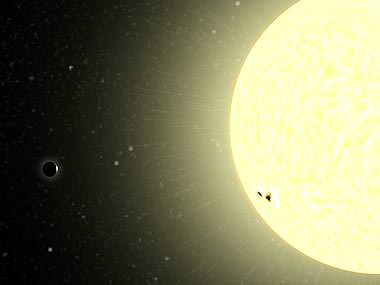[/caption] The CoRoT satellite has found the smallest terrestrial exoplanet yet, -- with a diameter just under twice that of Earth -- complete with a rocky surface you could walk on and possibly even oceans to sail across. However, if you traveled there, you might want to bring some protection, as the temperature of this planet is likely very high. CoRoT-Exo-7b is located very close to its parent star, orbiting once every 20 hours. Astronomers estimate temperatures on the planet could be between 1000 and 1500°C and it possibly could be covered in lava or water vapor. This latest exoplanet was detected as it transited in front of its parent star, dimming the light from the star just enough to be noticeable.
The parent star lies about 140 parsecs from Earth, located about half way between the star Sirius in Canis Major and Betelgeuse, the red giant star in Orion.
The internal structure of CoRoT-exo-7b particularly puzzles scientists; they are unsure whether it is an 'ocean planet', a kind of planet whose existence has never been proved so far. In theory, such planets would initially be covered partially in ice and they would later drift towards their star, with the ice melting to cover it in liquid. [caption id="attachment_24557" align="aligncenter" width="250" caption="COROT detects small, transiting exoplanet. Credits: CNES "]
[/caption] "This discovery is a very important step on the road to understanding the formation and evolution of our planet," said Malcolm Fridlund, ESA's CoRoT Project Scientist. "For the first time, we have unambiguously detected a planet that is 'rocky' in the same sense as our own Earth. We now have to understand this object further to put it into context, and continue our search for smaller, more Earth-like objects with COROT," he added.
About 330 exoplanets have been discovered so far, most of which are gas giants likeJupiter and Neptune. The density of COROT-Exo-7b is still under investigation: it may be rocky like Earth and covered in liquid lava. It may also belong to a class of planets that are thought to be made up of water and rock in almost equal amounts. Given the high temperatures measured, the planet would be a very hot and humid place.
"Finding such a small planet was not a complete surprise", said Daniel Rouan, researcher at the Observatoire de Paris Lesia, who coordinates the project with Alain Léger, from Institut d'Astrophysique Spatiale (Paris, France). "CoRoT-Exo-7b belongs to a class of objects whose existence had been predicted for some time. COROT was designed precisely in the hope of discovering some of these objects," he added.
Small terrestrial planets are difficult to detect, and so very few exoplanets found so far have a mass comparable to Earth, Venus, Mars, and Mercury. Most of the methods used to find planets are indirect and sensitive to the mass of the planet. The CoRoT spacecraft can directly measure the size of a planet's surface, which is an advantage. In addition, its location in space allows for longer periods of uninterrupted observation than from ground.
Astronomers say this discovery is significant because recent measurements have indicated the existence of planets of small masses but their size remained undetermined until now. CoRoT (
Co
nvection
Ro
tation and
T
ransits) was launched in December 2006 and consists of a 27 cm-diameter telescope designed to detect tiny changes the brightness of nearby stars. The mission's main objectives are to search for exoplanets and to study stellar interiors.
Source:
ESA
 Universe Today
Universe Today
